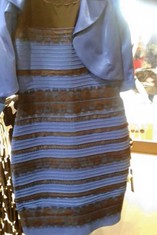NOTES FROM AN EMPTY TABLE
|
ESSAYS, POEMS, AND STORIES (BUT MOSTLY ESSAYS)
ON CULTURE, CALAMITY, AND CREATING BY TOM GUZZIO |
|
ESSAYS, POEMS, AND STORIES (BUT MOSTLY ESSAYS)
ON CULTURE, CALAMITY, AND CREATING BY TOM GUZZIO |
Doubt isn't the opposite of faith; it is an element of faith. - Paul Tillich  Photo credit: swike. Photo credit: swike. So much time and attention, airspace and bandwidth has been dedicated to one seemingly insignificant question: "what color is this dress?" Initially, my answer was not to answer. I was one of the smarmy minority who, dammit, felt that everyone's time would be better spent on other more pressing issues, like figuring out ways to stop ISIS, or coming up with a better gluten-free pizza crust. In doing so, I took my place among the ranks of what Megan Garber called "the attention police" in a recent article about the dress phenomenon. Still, "viral" is used to describe such things for a reason, so it didn't take long for me to offer up my opinion on the matter, mostly just to get people to stop asking (I even threatened to put it on a t-shirt). This dress is white and gold. Only it isn't. This dress is blue and black. My eyes let me down. I suppose I should find some solace in the scientific explanation for why millions of people see this same dress in two very distinct ways: the brain - which is truly responsible for making meaning from what we "see" - relies on our senses as gatherers of evidence, not arbiters of truth. In other words, seeing is a guessing game. This was explored in "Colors," a recent episode of WNYC's Radiolab, which you can sample an excerpt of below: As "Colors" shows, there is evidence that the vast majority of ancient peoples wouldn't have identified the dress as blue either, even if that's what they saw. This is because how we identify color is a social construct born of necessity. In The Illiad, for example, Homer famously described the ocean as "wine-colored," not because "blue" water didn't exist then, but because the Greeks had no need to label anything that way. With the exception of the Egyptians, the Greeks and other ancient cultures couldn't make blue pigments given the technology they had. Since they couldn't manufacture a color - say as a dye - then there was no need to give it a name. Since the next issue of Prodigal's Chair will be about faith and doubt, it's worth looking at what - if anything - the color of this dress can teach us about having faith or feeling doubt. Seriously. I think that ultimately faith, like color, is constructed by the brain, based on information it picks and chooses from those unreliable narrators through which we experience the world: our senses. The Book of Hebrews says that "faith is the substance of things hoped for, the evidence of things not seen." In this verse faith is about rooting our unreliable perceptions in a tangible reality. The ancient author implies that belief lives in the distance between what the eye shows us and the meaning the brain makes of it (even if he couldn't see blue). If that's the case, then doubt is the sum of those perceptions the brain tries to leave behind whenever you make a decision or adhere to a belief. Speaking of adherence, because I know my senses are wrong, it doesn't make sense for me too hold too tightly to what my eyes still see when I look at the picture: a white and gold dress. In this instance, I have the benefit of a definitive answer. All too often, this isn't the case with other divisive issues, like religion, politics, or which region of the country makes the best barbecue. If you're like me, you do the best you can, relying on what you see and feel to answer your questions and create a way through when the answers don't come. If you're not like me, then you're probably some sort of fundamentalist who can't see past this relativistic bull-pucky and you don't care what color the dress is because it's going STRAIGHT TO HELL!!! I'd rather take my faith with a grain of doubt. Because it won't be long before something else comes, breaks the internet, and challenges us to choose between this or that. If we're smart - better yet - if we're compassionate, we'll gracefully excuse those who don't see what we see. Unless, of course, it turns out the dress is really white and gold, and that the blue and black camp is simply fabricating stories like this to bolster their beliefs. Then it's time for pitch forks and torches. - Tom
Comments
|
This website uses marketing and tracking technologies. Opting out of this will opt you out of all cookies, except for those needed to run the website. Note that some products may not work as well without tracking cookies. Opt Out of CookiesARCHIVES:
June 2024
|
